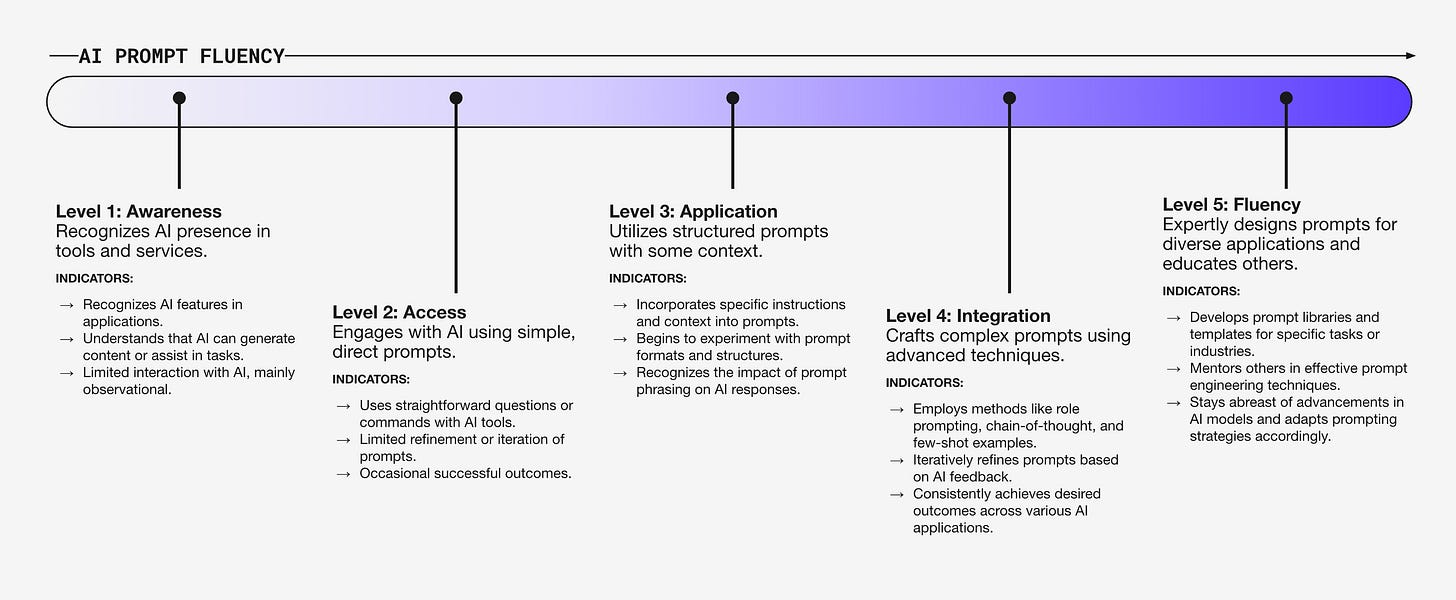Everyone Has Access. Few Have Fluency.
Giving your team access to AI is like handing them a dictionary and expecting them to write poetry.
The most dangerous assumption in AI adoption is that availability equals capability. Walk into any organization that's "implemented AI" and you'll find the same pattern: expensive tools sitting unused, confused teams avoiding the technology, and executives wondering why their AI investment isn't delivering results.
The corporate delusion is epidemic. "We bought ChatGPT licenses for everyone, so we're AI-ready." It's like saying you're ready to perform surgery because you bought a scalpel.
The future belongs to organizations that develop AI fluency, not just AI access.
The Access Illusion
Here's what actually happens when you give teams AI access without fluency: most tools sit unused or underused within weeks of deployment. Teams know AI exists but don't know how to make it work for them. The competence cliff is steep—they fall from enthusiasm to avoidance quickly.
The shadow usage problem is worse. Employees use AI tools poorly, creating more problems than solutions. They generate content that sounds sophisticated but lacks substance. They make decisions based on AI outputs they don't understand. They build dependencies on systems they can't evaluate.
The training fallacy compounds the problem. One-time workshops don't create lasting capability. Feature-focused training teaches what buttons to push instead of when to push them. Tool-centric curricula focus on specific platforms instead of underlying principles.
The result: teams that are technically "AI-enabled" but practically AI-helpless.
What Fluency Actually Looks Like
Fluency is the ability to think with AI, not just around it. It's the difference between using AI tools and being enhanced by them.
The Fluency Spectrum:
Level 1 - Awareness: "I know AI exists"
Level 2 - Access: "I can use AI tools"
Level 3 - Application: "I can apply AI to specific problems"
Level 4 - Integration: "I can weave AI into my workflow"
Level 5 - Fluency: "I can think strategically about when and how to use AI"
Most organizations get stuck at Level 2. They have access, but they don't have insight. They can generate AI outputs, but they can't evaluate AI quality. They can follow AI instructions, but they can't adapt AI responses.
Fluent users don't just use AI tools. They think differently because AI tools exist.
Fluency indicators include:
Prompt sophistication: Understanding how phrasing shapes AI responses
Context awareness: Knowing when AI helps and when it doesn't
Output evaluation: Distinguishing between good and poor AI results
Strategic application: Using AI to enhance thinking, not replace it
The gap between access and fluency is the gap between having a tool and knowing how to use it well.
Why Most AI Training Fails
Organizations treat AI fluency like software training when it's actually literacy development. The difference is profound.
Software training teaches you to use a specific tool. Literacy development teaches you to think in a new way. Software training has a clear endpoint. Literacy development is ongoing.
The common mistakes are predictable:
Feature-focused training: Teaching what buttons to push instead of when to push them
One-size-fits-all approach: Identical training for different roles and skill levels
Tool-centric curriculum: Focusing on specific platforms instead of underlying principles
Event-based learning: Single workshops instead of sustained development
AI fluency develops through practice, not presentations. Through iteration, not instruction.
The Fluency Development Framework
Build fluency systematically, not accidentally.
Stage 1: Foundation Building
Mental model development: How AI works conceptually
Workflow mapping: Where AI fits in existing processes
Use case identification: Specific problems AI could solve
Quality recognition: What good AI output looks like
Stage 2: Skill Building
Prompt engineering: Crafting effective AI interactions
Context management: Providing AI with relevant information
Output refinement: Improving AI results through iteration
Integration patterns: Incorporating AI into daily work
Stage 3: Strategic Thinking
Opportunity recognition: Identifying new AI applications
Risk assessment: Understanding AI limitations and pitfalls
Value evaluation: Measuring AI's impact on work quality
Continuous improvement: Evolving AI usage over time
Fluency isn't a destination. It's a development process that compounds over time.
The Organizational Fluency Challenge
Individual fluency doesn't automatically create organizational fluency. The scale problem is real: some teams become fluent while others lag behind. Knowledge silos develop when fluent individuals don't share learnings systematically.
Cultural resistance emerges when non-fluent team members feel threatened or excluded. Quality variance becomes obvious when some teams produce excellent AI-enhanced work while others produce garbage.
The systematic solution requires:
Community of practice: Regular forums for sharing AI learnings
Mentorship programs: Fluent users help develop others
Quality standards: Consistent criteria for AI output evaluation
Usage guidelines: Clear frameworks for when and how to use AI
Progress tracking: Systematic measurement of fluency development
Fluency spreads through culture, not policy. Through practice, not pronouncement.
The Competitive Advantage of Fluency
While others focus on AI access, fluent organizations focus on AI application. The fluency edge is measurable: fluent teams make better decisions faster. AI enhances rather than replaces human insight. Fluent organizations integrate new AI tools quickly.
The compound effect is powerful:
Year 1: Fluent teams work more efficiently
Year 2: Fluent organizations develop better strategies
Year 3: Fluent companies create new competitive advantages
AI fluency isn't a nice-to-have. It's the new digital literacy.
The Measurement Challenge
How do you measure something as complex as AI fluency? You track usage frequency, application breadth, output quality, integration depth, and strategic impact.
Assessment methods include skill demonstrations, peer reviews, output analysis, case studies, and progress tracking. What gets measured gets developed. Without fluency metrics, you can't build fluency systematically.
Building Your Fluency Strategy
Develop organizational AI fluency as a strategic capability:
Assess current state: Where is your organization on the fluency spectrum?
Identify fluency champions: Who are your natural AI adopters?
Create learning pathways: Systematic development for different skill levels
Build practice opportunities: Safe spaces to experiment and learn
Measure and iterate: Track progress and adjust approach
The cultural elements matter: psychological safety, recognition systems, resource allocation, leadership modeling, and continuous learning.
Fluency isn't something you achieve. It's something you cultivate.
Fluency gets you to the starting line. Context gets you to the finish line. Next, we'll explore AI's real competitive advantage.




